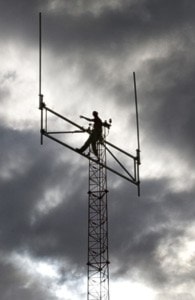If you’re talking to a buddy on the phone and they suddenly hang up on you, don’t hold it against them.
Blame the phone company.
Cellphones drop calls — it’s a fact of life in the mobile world.
But Whitehorse users are finding it harder and harder to connect their phones to a signal.
“I was in Tagish last week and I couldn’t even get a call out,” said Whitehorse-based web and technology specialist Andrew Robulack on Thursday.
“It has a lot to do with capacity and distance; a cell tower can only handle so many calls and if you have a fairly weak signal it will drop you,” said Robulack.
“I remember when the internet hit the same problem years ago in the North and you couldn’t get online because all the modem megs were full,” said Robulack.
The popularity of cellphones is pushing the limits of the cell towers.
“There has been a steady increase in the number of cellphone users in the Yukon ever since the service has been installed, for sure,” said Chris McNutt, manager of marketing and communications for Latitude and Northwestel Mobility Incorporated.
Latitude Wireless is a partnership between Northwestel, which is wholly owned by Bell Canada, and the Dakwakada Development Corporation, the business investment arm of the Champagne/Aishihik First Nations.
The company, with a storefront on Second Avenue, opened in June.
NMI was bought by Bell three years ago.
“NMI acknowledges there are capacity issues on the Whitehorse cell system,” said McNutt.
He says there are two challenges the cell industry is facing — dropped calls and not being able to connect at all.
And those two issues sometimes happen for different reasons.
For example, the signal to a cellphone can be finicky.
“If a phone isn’t connecting at all it may sometimes be as simple as shifting a step to the right, or taking your phone out of your pocket,” said McNutt.
“The challenge we have in Whitehorse is the number of cell sites; in a place like Vancouver, you’re surrounded by towers so you can pick up the signal from a number of places.”
It also can depend on the nature of the call. For example, if a cell user calls another cell user on the system, that conversation uses twice as much capacity as one from a cell user to a land-based line, he said.
Although the transmission lines are taxed, cellphones drop calls for many different reasons, said McNutt.
For example, moving around into dead spots, and barriers, like foliage or metal roofs, can hinder transmission signals.
Poor handset quality and low batteries can also lead to abbreviated calls.
Meanwhile, to ease congestion and prepare for the 2007 Canada Winter Games, NMI/Bell is planning significant capacity upgrades on its sites at Haeckel Hill, the Canada Games Centre and downtown Whitehorse.
It plans to have the upgrades completed by December 1.
Currently, there are three different cellphone companies and three different networks in place in the Yukon: Latitude, Bell/NMI and ICE Wireless.
Latitude was created to serve the Yukon’s communities and, so far, has 10 of 17 in service — Watson Lake, Upper Liard, Teslin, Carcross, Tagish, Haines Junction, Destruction Bay, Burwash, Beaver Creek and Mayo. It expects to have three more in service by December 1.
The Bell/NMI network only serves Whitehorse and Tagish.
And the ICE Wireless network only works in Whitehorse, but plans to expand to Yellowknife, Inuvik, Aklavik, Tuktoyaktuk, Norman Wells, Fort Simpson and Hay River.
In the world of cell service, there are two major platforms and, like VHS and Beta videotapes, they are not compatible.
Both the Latitude and Bell/NMI networks use CDMA and are compatible, so customers of either service can roam and use either network.
But the ICE Wireless network, which uses GSM, is not.
Representatives from ICE Wireless were not available for comment before press time.
